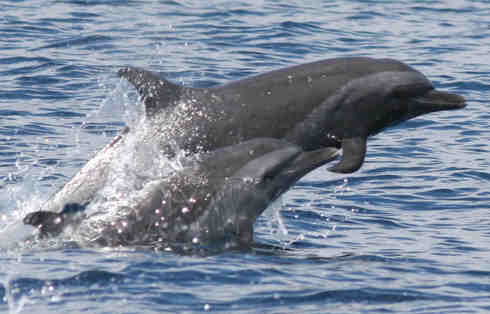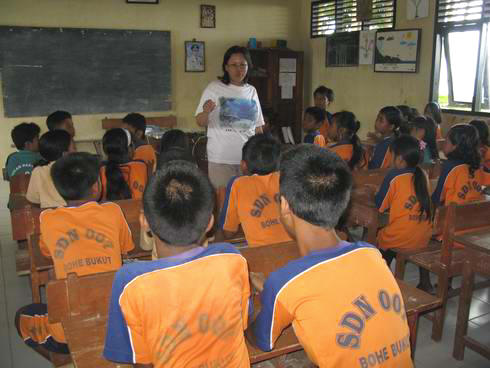|
Cetacean Diversity
Surveys Around Derawan Islands
 After
a preliminary survey in 2003 by RASI in collaboration with the University of
Amsterdam and WOTRO, two surveys were conducted in October 2007 and April
2008 to investigate the diversity of marine mammals in de marine protected
area of Berau archipelago in collaboration with the Conservation Agency
BKSDA Berau and University of Mulawarman. Skin/ blubber biopsy samples were
obtained from several dolphin species by invited researcher Dr. Robert L.
Pitman from NOAA Southwest Fisheries Science Center, La Jolla USA were DNA
analyses will be performed. Species involved: spinner dolphin, dwarf spinner
dolphin, common bottlenose dolphin, Indo-Pacific bottlenose dolphin, spotted
dolphin. After
a preliminary survey in 2003 by RASI in collaboration with the University of
Amsterdam and WOTRO, two surveys were conducted in October 2007 and April
2008 to investigate the diversity of marine mammals in de marine protected
area of Berau archipelago in collaboration with the Conservation Agency
BKSDA Berau and University of Mulawarman. Skin/ blubber biopsy samples were
obtained from several dolphin species by invited researcher Dr. Robert L.
Pitman from NOAA Southwest Fisheries Science Center, La Jolla USA were DNA
analyses will be performed. Species involved: spinner dolphin, dwarf spinner
dolphin, common bottlenose dolphin, Indo-Pacific bottlenose dolphin, spotted
dolphin.

At least 15 cetacean
species were directly observed and one dugong species, whereas based on
reliable information sperm whales and killer whales also visit the area,
bringing the total number of cetacean species for this area to 17 species. A
species that still needs further clarification is a remarkably long-beaked
from of common dolphins, i.e. Delphinus capensis
tropicalis (see picture).
Besides, first records of
humpback whales were made in deep slope waters near Bontang, c. 100 km north
from the Mahakam Delta. We hope to be able to start soon conducting more
surveys in this area.
(Technical
Report ....... pdf 534kb)
Cetaceans Diversity Around
Balikpapan Bay
 Marine mammal
observation surveys were conducted in Balikpapan Bay in East Kalimantan in
2008 in order to obtain information on cetacean diversity, total abundance,
distribution patterns and threats. A total of 985
km of line-transects were surveyed in 84.9 hours in 16 days during three
surveys in May, June and November 2008. The surveys were
compared with the results from two surveys in 2000 and two in 2001, which
were conducted during similar seasons Marine mammal
observation surveys were conducted in Balikpapan Bay in East Kalimantan in
2008 in order to obtain information on cetacean diversity, total abundance,
distribution patterns and threats. A total of 985
km of line-transects were surveyed in 84.9 hours in 16 days during three
surveys in May, June and November 2008. The surveys were
compared with the results from two surveys in 2000 and two in 2001, which
were conducted during similar seasons to assess changes in abundance and distribution.
to assess changes in abundance and distribution.
Three cetacean species, i.e. Irrawaddy dolphin
(Orcaella brevirostris),
Finless porpoise Neophocaena phocaenoides, and Indo-Pacific
bottlenose dolphin, Tursiops aduncus were encountered during all
surveys as well as dugongs Dugong Dugon. The finless porpoise and
bottlenose dolphins occurred in low densities in the outer coastal bay
segment, and dugongs in several bay segments in very low densities.
Irrawaddy dolphins were the species most commonly encountered but were
almost exclusively sighted in the upper parts of the bay in 2008, whereas
during 2000 and 2001 they also significantly occurred in the lower bay
segments downstream of Tanjung Batu and near coastal area. Individual
dolphins also show a high site-fidelity throughout the seasons.
Best estimates of mean abundance in 2008 were between 67 and 140 individuals
based on the Burnham & Overton mark-recapture- and line -transect density
analysis, respectively. No significant changes in mean abundance were found
between 2000, 2001 and 2008. The disappearance of Irrawaddy dolphins in the
lower bay segments is likely caused by increasing boat traffic and
industrial activities in the lower segments, as well as increased
sedimentation impacting on fisheries in these areas due to mangrove
conversion. The preservation of mangroves of the upper bay segments, above
Tanjung Batu, and prevention of industrial activities in these segments
including prevention of bridge construction plans in this segment, is
essential for the preservation of the Irrawaddy dolphins and dugongs in the
bay. Since the dolphins live in close contact with the human population in
the bay, increasing awareness is similarly important. -transect density
analysis, respectively. No significant changes in mean abundance were found
between 2000, 2001 and 2008. The disappearance of Irrawaddy dolphins in the
lower bay segments is likely caused by increasing boat traffic and
industrial activities in the lower segments, as well as increased
sedimentation impacting on fisheries in these areas due to mangrove
conversion. The preservation of mangroves of the upper bay segments, above
Tanjung Batu, and prevention of industrial activities in these segments
including prevention of bridge construction plans in this segment, is
essential for the preservation of the Irrawaddy dolphins and dugongs in the
bay. Since the dolphins live in close contact with the human population in
the bay, increasing awareness is similarly important.
(Technical
Report ..... pdf 628kb)
Coastal Awareness
Campaign
 Coastal
environmental campaigns were held in Derawan, Maratua, Tanjung Batu (Berau
district) as well as in villages, cities surrounding Balikpapan Bay and
coastal communities near Bontang and Mahakam Delta. Posters informing about
marine mammals, strandings and rescues and conservation were handed to all
areas mentioned earlier as well as data collected from fishermen. Campaigns
were also held at elementary and high schools dealing with marine mammals,
protection of coastal habitat, mangroves and natural resources. Coastal
environmental campaigns were held in Derawan, Maratua, Tanjung Batu (Berau
district) as well as in villages, cities surrounding Balikpapan Bay and
coastal communities near Bontang and Mahakam Delta. Posters informing about
marine mammals, strandings and rescues and conservation were handed to all
areas mentioned earlier as well as data collected from fishermen. Campaigns
were also held at elementary and high schools dealing with marine mammals,
protection of coastal habitat, mangroves and natural resources.
|

 After
a preliminary survey in 2003 by RASI in collaboration with the University of
Amsterdam and WOTRO, two surveys were conducted in October 2007 and April
2008 to investigate the diversity of marine mammals in de marine protected
area of Berau archipelago in collaboration with the Conservation Agency
BKSDA Berau and University of Mulawarman. Skin/ blubber biopsy samples were
obtained from several dolphin species by invited researcher Dr. Robert L.
Pitman from NOAA Southwest Fisheries Science Center, La Jolla USA were DNA
analyses will be performed. Species involved: spinner dolphin, dwarf spinner
dolphin, common bottlenose dolphin, Indo-Pacific bottlenose dolphin, spotted
dolphin
After
a preliminary survey in 2003 by RASI in collaboration with the University of
Amsterdam and WOTRO, two surveys were conducted in October 2007 and April
2008 to investigate the diversity of marine mammals in de marine protected
area of Berau archipelago in collaboration with the Conservation Agency
BKSDA Berau and University of Mulawarman. Skin/ blubber biopsy samples were
obtained from several dolphin species by invited researcher Dr. Robert L.
Pitman from NOAA Southwest Fisheries Science Center, La Jolla USA were DNA
analyses will be performed. Species involved: spinner dolphin, dwarf spinner
dolphin, common bottlenose dolphin, Indo-Pacific bottlenose dolphin, spotted
dolphin


 -transect density
analysis, respectively. No significant changes in mean abundance were found
between 2000, 2001 and 2008. The disappearance of Irrawaddy dolphins in the
lower bay segments is likely caused by increasing boat traffic and
industrial activities in the lower segments, as well as increased
sedimentation impacting on fisheries in these areas due to mangrove
conversion. The preservation of mangroves of the upper bay segments, above
Tanjung Batu, and prevention of industrial activities in these segments
including prevention of bridge construction plans in this segment, is
essential for the preservation of the Irrawaddy dolphins and dugongs in the
bay. Since the dolphins live in close contact with the human population in
the bay, increasing awareness is similarly important.
-transect density
analysis, respectively. No significant changes in mean abundance were found
between 2000, 2001 and 2008. The disappearance of Irrawaddy dolphins in the
lower bay segments is likely caused by increasing boat traffic and
industrial activities in the lower segments, as well as increased
sedimentation impacting on fisheries in these areas due to mangrove
conversion. The preservation of mangroves of the upper bay segments, above
Tanjung Batu, and prevention of industrial activities in these segments
including prevention of bridge construction plans in this segment, is
essential for the preservation of the Irrawaddy dolphins and dugongs in the
bay. Since the dolphins live in close contact with the human population in
the bay, increasing awareness is similarly important. Coastal
environmental campaigns were held in Derawan, Maratua, Tanjung Batu (Berau
district) as well as in villages, cities surrounding Balikpapan Bay and
coastal communities near Bontang and Mahakam Delta. Posters informing about
marine mammals, strandings and rescues and conservation were handed to all
areas mentioned earlier as well as data collected from fishermen. Campaigns
were also held at elementary and high schools dealing with marine mammals,
protection of coastal habitat, mangroves and natural resources.
Coastal
environmental campaigns were held in Derawan, Maratua, Tanjung Batu (Berau
district) as well as in villages, cities surrounding Balikpapan Bay and
coastal communities near Bontang and Mahakam Delta. Posters informing about
marine mammals, strandings and rescues and conservation were handed to all
areas mentioned earlier as well as data collected from fishermen. Campaigns
were also held at elementary and high schools dealing with marine mammals,
protection of coastal habitat, mangroves and natural resources.